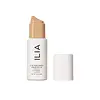What's inside
What's inside
 Key Ingredients
Key Ingredients

 Benefits
Benefits

 Concerns
Concerns

 Ingredients Side-by-side
Ingredients Side-by-side

Undecane
EmollientTridecane
PerfumingSimmondsia Chinensis Seed Oil
EmollientMica
Cosmetic ColorantHydrogenated Styrene/Isoprene Copolymer
Silica
AbrasiveKaolin
AbrasiveCocos Nucifera Oil
MaskingHydrogenated Olive Oil Unsaponifiables
EmollientBalanites Roxburghii Seed Oil
Skin ConditioningHydrogenated Vegetable Oil
EmollientVanillin
MaskingHectorite
AbsorbentCandelilla Cera
EmollientElaeis Guineensis Oil
EmollientGossypium Herbaceum Seed Oil
Skin ConditioningBidens Pilosa Extract
HumectantTocopherol
AntioxidantLinum Usitatissimum Seed Oil
PerfumingPentaerythrityl Tetra-Di-T-Butyl Hydroxyhydrocinnamate
AntioxidantAlumina
AbrasiveMagnesium Oxide
AbsorbentUndecane, Tridecane, Simmondsia Chinensis Seed Oil, Mica, Hydrogenated Styrene/Isoprene Copolymer, Silica, Kaolin, Cocos Nucifera Oil, Hydrogenated Olive Oil Unsaponifiables, Balanites Roxburghii Seed Oil, Hydrogenated Vegetable Oil, Vanillin, Hectorite, Candelilla Cera, Elaeis Guineensis Oil, Gossypium Herbaceum Seed Oil, Bidens Pilosa Extract, Tocopherol, Linum Usitatissimum Seed Oil, Pentaerythrityl Tetra-Di-T-Butyl Hydroxyhydrocinnamate, Alumina, Magnesium Oxide
Zinc Oxide 10%
Cosmetic ColorantSqualane
EmollientAscorbic Acid
AntioxidantShea Butter Ethyl Esters
EmollientPolymethylsilsesquioxane
Simmondsia Chinensis Seed Oil
EmollientLimnanthes Alba Seed Oil
Skin ConditioningButyloctyl Salicylate
Skin ConditioningCaprylic/Capric Triglyceride
MaskingC9-12 Alkane
SolventC12-15 Alkyl Benzoate
AntimicrobialNiacinamide
SmoothingSilica Silylate
EmollientMethylpropanediol
SolventLecithin
EmollientTocopherol
AntioxidantSilica
AbrasivePolyglyceryl-2 Dipolyhydroxystearate
Skin ConditioningEthylene/Propylene/Styrene Copolymer
Allantoin
Skin ConditioningBisabolol
MaskingCaprylyl Glycol
EmollientPhenylpropanol
MaskingOryza Sativa Bran Extract
Skin ConditioningButylene/Ethylene/Styrene Copolymer
Helianthus Annuus Extract
EmollientPolyglyceryl-4 Diisostearate/Polyhydroxystearate/Sebacate
EmulsifyingPentaerythrityl Tetra-Di-T-Butyl Hydroxyhydrocinnamate
AntioxidantRosmarinus Officinalis Leaf Extract
AntimicrobialHydrogenated Lecithin
EmulsifyingCI 77491
Cosmetic ColorantCI 77492
Cosmetic ColorantCI 77499
Cosmetic ColorantZinc Oxide 10%, Squalane, Ascorbic Acid, Shea Butter Ethyl Esters, Polymethylsilsesquioxane, Simmondsia Chinensis Seed Oil, Limnanthes Alba Seed Oil, Butyloctyl Salicylate, Caprylic/Capric Triglyceride, C9-12 Alkane, C12-15 Alkyl Benzoate, Niacinamide, Silica Silylate, Methylpropanediol, Lecithin, Tocopherol, Silica, Polyglyceryl-2 Dipolyhydroxystearate, Ethylene/Propylene/Styrene Copolymer, Allantoin, Bisabolol, Caprylyl Glycol, Phenylpropanol, Oryza Sativa Bran Extract, Butylene/Ethylene/Styrene Copolymer, Helianthus Annuus Extract, Polyglyceryl-4 Diisostearate/Polyhydroxystearate/Sebacate, Pentaerythrityl Tetra-Di-T-Butyl Hydroxyhydrocinnamate, Rosmarinus Officinalis Leaf Extract, Hydrogenated Lecithin, CI 77491, CI 77492, CI 77499
Ingredients Explained
These ingredients are found in both products.
Ingredients higher up in an ingredient list are typically present in a larger amount.
Pentaerythrityl Tetra-Di-T-Butyl Hydroxyhydrocinnamate (long name, huh?) is a synthetic antioxidant.
It is used to help stabilize other antioxidants or prevent the color from changing in a product.
As an antioxidant, it helps fight free-radical molecules. Free-radical molecules are capable of damaging our cells and other genetic material. Thus, antioxidants may reduce the signs of aging.
This ingredient is oil-soluble.
Learn more about Pentaerythrityl Tetra-Di-T-Butyl HydroxyhydrocinnamateSilica, also known as silicon dioxide, is a naturally occurring mineral. It is used as a fine, spherical, and porous powder in cosmetics.
Though it has exfoliant properties, the function of silica varies depending on the product.
The unique structure of silica enhances the spreadability and adds smoothness, making it a great texture enhancer.
It is also used as an active carrier, emulsifier, and mattifier due to its ability to absorb excess oil.
In some products, tiny microneedles called spicules are made from silica or hydrolyzed sponge. When you rub them in, they lightly polish away dead skin layers and enhance the penetration of active ingredients.
Learn more about SilicaThis oil comes from the seeds of the desert shrub called Jojoba. It is more commonly known as jojoba oil, a non-comedogenic oil.
Jojoba oil does not contain fragrance and has many fatty-acids, making it a great soothing ingredient.
It also contains Vitamin E, a great moisturizing ingredient. Vitamin E is also an antioxidant and protects your skin against oxidative damage.
This ingredient humectant properties, meaning it helps draw moisture from the air. This helps keep your skin hydrated.
While jojoba has antibacterial properties, it is only able to kill some strains of bacteria.
Studies also show it helps in wound healing. In fact, Indigenous cultures have used jojoba as a moisturizer and to help treat burns for centuries.
Fun fact: Jojoba oil similar to natural human skin sebum, so it has a great effect on dry skin. It is also promising with helping to regulate sebum production.
Due to its fatty acid content, Jojoba oil may not be fungal acne safe. We recommend speaking with a professional if you have any concerns.
Learn more about Simmondsia Chinensis Seed OilTocopherol (also known as Vitamin E) is a common antioxidant used to help protect the skin from free-radicals and strengthen the skin barrier. It's also fat soluble - this means our skin is great at absorbing it.
Vitamin E also helps keep your natural skin lipids healthy. Your lipid skin barrier naturally consists of lipids, ceramides, and fatty acids. Vitamin E offers extra protection for your skin’s lipid barrier, keeping your skin healthy and nourished.
Another benefit is a bit of UV protection. Vitamin E helps reduce the damage caused by UVB rays. (It should not replace your sunscreen). Combining it with Vitamin C can decrease sunburned cells and hyperpigmentation after UV exposure.
You might have noticed Vitamin E + C often paired together. This is because it is great at stabilizing Vitamin C. Using the two together helps increase the effectiveness of both ingredients.
There are often claims that Vitamin E can reduce/prevent scarring, but these claims haven't been confirmed by scientific research.
Learn more about Tocopherol